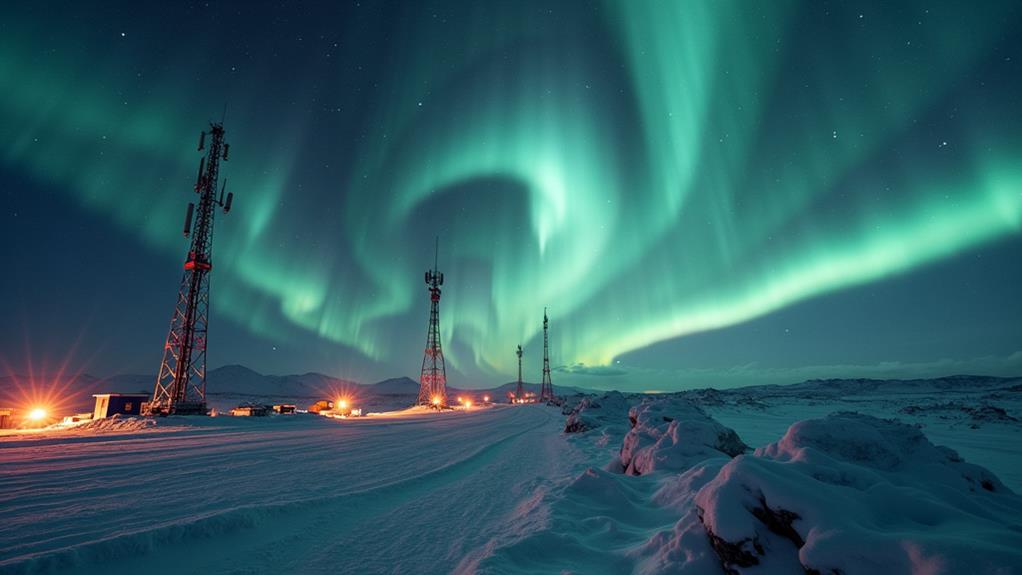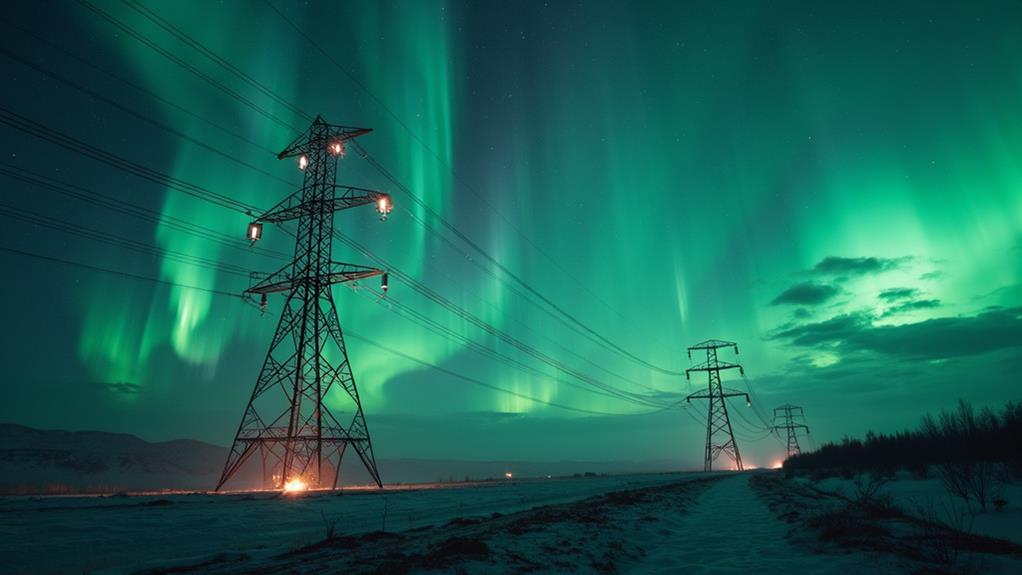The Impact of the Northern Lights on Navigation and Communication Systems

When you think about the Northern Lights, you probably picture mesmerizing displays of color dancing across the sky. However, their less enchanting effects on navigation and communication systems are significant. The charged particles responsible for these stunning visuals can disrupt Global Navigation Satellite Systems (GNSS) like GPS, leading to considerable positioning errors. These disruptions are particularly concerning for critical sectors such as transportation and aviation. Additionally, geomagnetic storms can render high-frequency communications unreliable. So, how do these natural phenomena affect our technological infrastructure, and what measures can be taken to mitigate these impacts?
Understanding the Northern Lights
When you witness the Northern Lights, also known as the Aurora Borealis, you're actually observing charged particles from the Sun interacting with Earth's magnetic field. These vibrant displays typically occur in high-latitude regions, creating a mesmerizing spectacle. However, the beauty of the auroras masks their potential to disrupt vital technologies.
As these charged particles collide with Earth's magnetic field, they generate disturbances in the ionosphere—a layer crucial for satellite communications and Global Navigation Satellite Systems (GNSS). These auroral disturbances can cause inaccuracies in satellite positioning, which are fundamental for navigation systems. Geomagnetic storms triggered by the Northern Lights can significantly alter the ionosphere's density.
Research from the University of Bath has revealed that the mechanisms behind these disturbances are more complex than previously thought, involving unknown processes rather than just plasma turbulence. Collaborative efforts with the European Incoherent Scatter Scientific Association (EISCAT), using radar and GNSS receivers, have provided valuable insights into how auroras interfere with satellite signals. Understanding these effects is essential for developing more reliable navigation systems and ensuring robust satellite communications in the face of auroral activity.
Disruption of GNSS Systems
Auroras can disrupt Global Navigation Satellite Systems (GNSS), causing inaccuracies that impact essential sectors such as transportation and civil aviation. When the Northern Lights illuminate the sky, they not only provide a breathtaking visual display but also interfere with GNSS systems like GPS, GLONASS, and Galileo. This interference results in significant positioning errors, posing risks to navigation technologies that rely on precise data.
Research conducted in Tromsø, Norway, using radar and GNSS receivers, has demonstrated how auroras create interference patterns that disrupt satellite signals. Recent findings from the University of Bath suggest that previously assumed turbulence is not the primary cause of these inaccuracies, indicating that unknown mechanisms are responsible for the disruptions. This discovery highlights the complexity of the issue and underscores the need for further investigation.
As our reliance on GNSS increases—particularly with the advent of 5G networks—it is crucial to understand and mitigate these disruptions. Developing robust navigation technologies that can withstand interference from auroras and related solar storms is essential. Without these advancements, positioning errors could compromise the dependability of critical communication systems and navigation services.
Solar Storm Effects on Communication

Solar storms, despite their mesmerizing beauty, pose significant threats to our communication systems. Geomagnetic storms, particularly those triggered by coronal mass ejections (CMEs), can profoundly affect GPS signals, leading to inaccuracies in GPS positioning. Such inaccuracies are critical for sectors like transport and aviation. These disruptions occur because increased solar activity interferes with the ionosphere, altering how radio waves propagate.
High-frequency (HF) communications, which rely on ionospheric reflection, also become unreliable during geomagnetic storms, making long-distance communication challenging. Severe geomagnetic storms can induce damaging currents in satellites, affecting satellite communications and potentially causing failures in navigation systems that depend on GNSS, including GPS.
The NOAA's Space Weather Prediction Center has noted that intense geomagnetic activity can disrupt satellite communications at frequencies around 1 GHz, impacting various technologies used daily.
In summary, the effects of geomagnetic storms on communication systems include:
- Disruption of GPS signals.
- Unreliability of HF communications.
- Potential damage to satellite systems from induced currents.
- Altered radio wave propagation due to increased ionospheric density.
Understanding these risks is essential for developing robust electrical engineering solutions to mitigate such impacts.
Resilience of Land Mobile Radio
Solar storms can disrupt many communication systems, but Land Mobile Radio (LMR) is notably resilient during such events. Unlike high-frequency communications that depend on ionospheric reflection, LMR operates in the VHF (136-225 MHz) and UHF (330-530 MHz) bands, which rely on line-of-sight propagation. This key distinction makes LMR less vulnerable to the disruptive effects of geomagnetic storms.
During a geomagnetic storm, there might be a slight increase in the noise floor, potentially affecting the communication range of LMR systems. However, this impact is minimal and does not significantly impair functionality. LMR systems are engineered to maintain reliability over short distances, typically a few kilometers, ensuring that critical communication remains operational.
For emergency services and first responders, this resilience is crucial. Even in severe geomagnetic storms, LMR systems continue to function effectively, enabling these essential services to perform their duties. While antenna currents may vary due to changes in the geomagnetic field, the overall impact on LMR systems is minor compared to other communication forms. This reliability makes LMR a dependable choice for maintaining communication during geomagnetic events.
Power Grid Vulnerabilities

You might be surprised to learn how vulnerable our power grids are to geomagnetic storms. These storms, triggered by solar flares and heightened solar activity, can induce strong currents in power lines, known as geomagnetically induced currents (GICs). These GICs can exceed 100 amperes, causing severe transformer damage and even complete power system failures.
Consider the March 1989 geomagnetic storm that led to a grid collapse in Quebec, affecting 5 million people. This event showcased the fragility of modern electrical systems when faced with intense solar activity. Given society's heavy reliance on electricity, the financial repercussions of such disturbances can reach trillions of dollars.
To mitigate these risks, power companies need to improve their monitoring of solar activity and implement precautionary measures. Engineers advocate for protective technologies and strategies to strengthen the resilience of power grids against geomagnetic storms.
Here's why this is vital:
- Transformer damage due to GICs can lead to widespread outages.
- Electrical systems are more susceptible now than historical technologies.
- Precautionary measures can prevent catastrophic failures.
- Improved monitoring of solar activity helps in timely interventions.
Ensuring robust power grids is fundamental not just for electricity, but also for the stability of navigation and communication systems.




